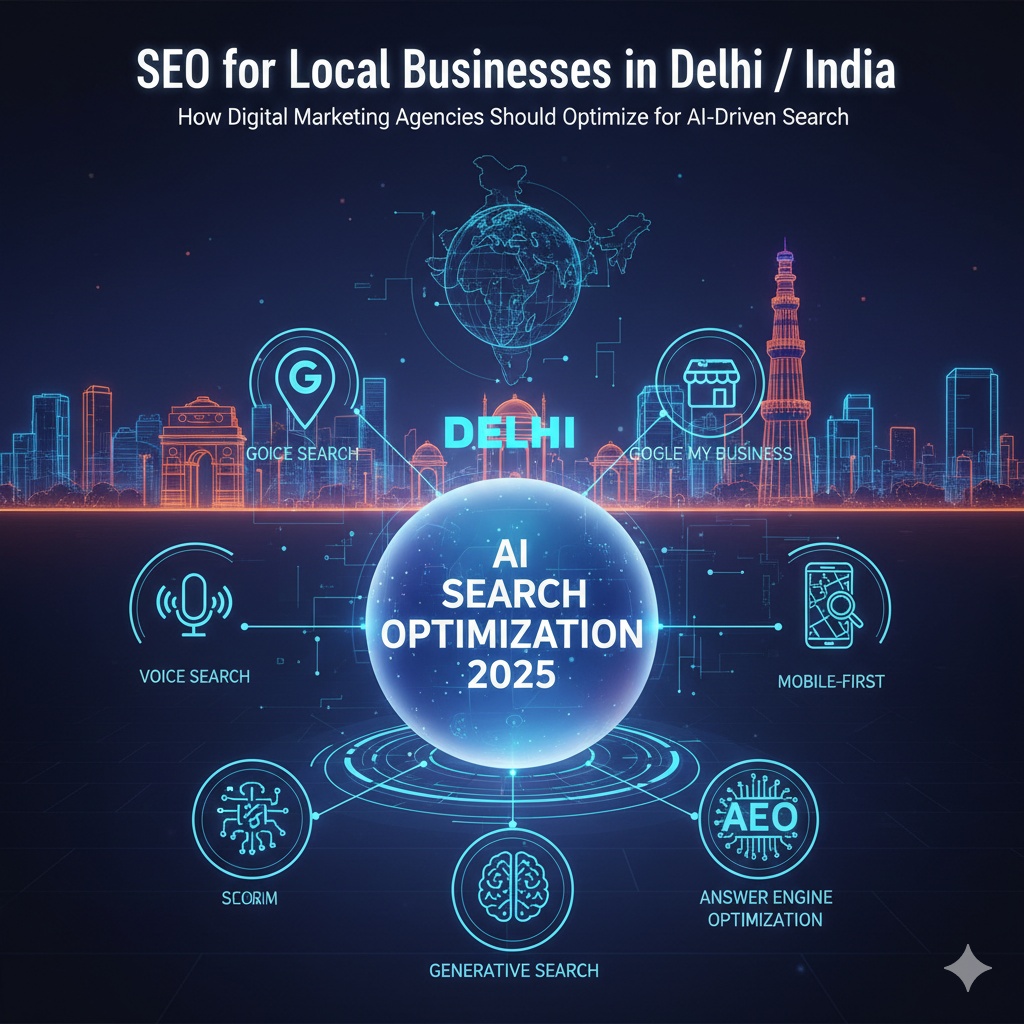Table of Contents
Generative Search & AEO: How Digital Marketing Agencies Should Optimize for AI-Driven Search in 2025
In 2025, the search landscape is undergoing a profound transformation. Traditional SEO tactics — keyword stuffing, link quantity, meta tags — remain important, but they’re no longer sufficient on their own. As AI, voice assistants, and generative search engines (like Google’s SGE, Bing Chat, etc.) gain dominance, digital marketing agencies must adapt to the new paradigm: Answer Engine Optimization (AEO) and Generative Engine Optimization (GEO).
For local businesses in Delhi, India — small shops, clinics, salons, service providers — the stakes are high. Consumers increasingly use voice search (“Ok Google, salon near me”), mobile devices, and expect instant, conversational results. If your local SEO doesn’t evolve, you risk losing visibility even if you rank #1 in traditional search.
This blog dives into how agencies should optimize for this AI-driven era, covering:
-
Voice search & conversational SEO for local businesses
-
Google My Business (now Google Business Profile) best practices
-
Mobile-first indexing and its deeper implications
-
Generative Search, AEO / GEO, and how to prepare for AI Overviews
-
A combined optimization framework tailored for local Delhi / Indian businesses
-
A conclusion that ties it all together
Let’s begin by exploring voice search’s growing role.
Why Voice Search Matters More in India / Delhi
India is a hotbed for voice adoption:
-
Many users speak queries rather than type, especially on mobile (Hindi, Hinglish, regional languages).
-
Local & “near me” voice queries are among the fastest-growing segments.
-
As data becomes cheaper and smartphone penetration grows, voice assistants (Google Assistant, Alexa) become default.
For a local business (say, a clinic in South Delhi or a café in Dwarka), the difference between being found via voice vs text search is huge. You might get traffic or footfall — or be invisible.
Conversational / Question-Based Keywords
Voice search is conversational: users ask full questions, not short keywords. For example:
-
“Where is the best chicken biryani near me in Delhi?”
-
“Which salon in GK1 does bridal makeup?”
-
“Is there a 24×7 pharmacy in Lajpat Nagar?”
Thus, your SEO must shift from targeting “salon Delhi” to targeting how / where / which questions. Use tools like AnswerThePublic, AlsoAsked, Google’s “People Also Ask” to unearth these.
Voice Search & Featured Snippets / Zero Click
Many voice assistants pull from featured snippets / answer boxes. If your content is in a snippet, you have a shot of being read aloud. Therefore:
-
Structure content in lists, bullet points, short paragraphs
-
Use “Answer + details” pattern
-
Use Schema (FAQ, Q&A) to signal structure
Google My Business (Google Business Profile) & Local Signals
For local SEO, the Google Business Profile (GBP) / Google My Business is a cornerstone. Especially when users search with “near me” or on maps. Here’s how to optimize it in 2025.
Complete and Accurate Business Profile
Ensure all fields are filled:
-
Business name, address, phone number (NAP) — consistent across web
-
Business category, description, services
-
Operating hours (special hours, holidays)
-
Images (exterior, interior, staff)
-
Attributes (e.g. “women-led”, “online appointments”)
Google uses this to match local intent. If your GBP is incomplete, voice assistants may skip you.
Reviews, Ratings & Q&A
Reviews matter now more than ever:
-
Encourage customers to leave reviews (with keywords: “salon in South Delhi”, etc.).
-
Respond to reviews — this signals engagement and authority.
-
Use the Q&A section on your Google profile — proactively post likely voice queries and answers (e.g. “Do you offer keratin hair treatment?”).
These help in voice and AI responses.
Local Citations & Consistency
Your name, address, phone number must be consistent across:
-
Your website
-
GBP
-
Local directories (JustDial, Sulekha, etc.)
-
Social profiles
Inconsistencies damage trust and rankings.
Use of Local Schema / Structured Data
On your website, embed LocalBusiness, Organization, Product / Service, FAQ schema so search engines (and AI engines) can parse your data easily.
Schema helps Google, voice assistants, AI-overviews pick up structured facts and show them.
Mobile-First & Technical Foundations
Mobile-First Indexing & Performance
Google now mainly uses the mobile version of content for indexing and ranking. So:
-
Your site must be fully responsive
-
Use a mobile-friendly design (buttons tappable, fonts readable)
-
Ensure fast loading (aim under 2–3 seconds)
-
Optimize images (compress, use next-gen formats)
-
Use lazy loading, minimal JS bloat
If your desktop version is richer but mobile is sparse, you lose ranking power.
Core Web Vitals & UX Signals SEO for Local Businesses
Core Web Vitals (Largest Contentful Paint, First Input Delay, Cumulative Layout Shift) matter for ranking. Poor UX kills voice / AI ranking chances.
Aim for:
-
LCP < 2.5s
-
FID < 100ms
-
CLS < 0.1
Also focus on:
-
Minimal popups / interstitials
-
Clear navigation
-
Good internal linking
-
Accessibility (alt text, ARIA labels, readable fonts)
Technical SEO for Local Businesses
Even in an AI-driven world, your content must be crawlable and indexable:
-
Use XML sitemaps
-
Use robots.txt properly
-
Ensure pages are not orphaned
-
Avoid duplicate content
-
Use canonical URLs
-
Use structured metadata (title tags, meta descriptions, schema)
Also, mobile crawl budgets matter — avoid too many heavy scripts.
Generative Search, AEO & GEO: The AI Era
Here’s where things shift dramatically from “just SEO” to AI / generative optimization.
What Are AEO, GEO & AI Overviews?
-
AEO (Answer Engine Optimization) is about structuring content so that AI systems (Google SGE, chatbots) can directly extract your content as answers.
-
GEO (Generative Engine Optimization) is optimizing for AI-driven synthesis (how generative models pick, paraphrase, cite your content).
-
AI Overviews are the summaries / snapshots Google generates at the top of SERPs using generative AI (previously called SGE) that combine sources.
In short: in 2025, many users may see the AI overview first — and not scroll to organic listings. To be featured in AI Overviews, your content must be well structured, authoritative, and directly answer queries.
SEO for Local Businesses vs AEO: Complementary, Not Opposing
SEO is still foundational — without good rankings, you won’t be part of AI Overviews. But now:
-
SEO helps you rank in traditional SERPs
-
AEO helps you be the answer in AI responses
-
GEO bridges the two by making content friendly to generative models
“If your page isn’t in the top results, it’s much less likely to be included in the AI answer.
So your content must support both.
Content ideas that capture AI-driven local traffic
Create hyper-local landing pages for neighbourhoods (e.g., Greater Kailash, Connaught Place, Saket). Each page should answer common voice queries and reference nearby landmarks. Produce short, scannable service pages with an immediate answer at the top, followed by detailed supporting content. Use numbered lists, tables, and clear headings — formats AI systems prefer when assembling answers.
Reviews, reputation and conversions
Reviews are trust signals for both users and AI systems. Encourage recent, specific reviews that mention services, locations, and outcomes. Reply to reviews promptly to demonstrate engagement. Use review snippets and highlighted customer quotes in your GBP and on-site content to feed AI models with high-quality, factual signals.
Local links and partnerships
Partner with Delhi blogs, local events, and neighbourhood directories to gain contextual links and mentions. Sponsor hyper-local events and secure coverage that references your business name and area. These mentions help search engines corroborate your entity’s authority and location information, which is critical in an AEO environment.
Tracking success in an AEO world
Measure visibility with a mix of traditional and new metrics: GBP views and actions, voice-driven conversions, featured snippet capture, and traffic from neighbourhood landing pages. Track calls, direction requests, bookings, and messages as direct business outcomes. Use Search Console’s query reports to spot rising conversational queries and tune content accordingly.
Service packaging: how agencies should price local SEO for Local Businesses
Offer tiered local SEO packages:
-
Starter — GBP setup, citation cleanup, basic local schema, monthly reporting.
-
Growth — Voice optimization, neighbourhood pages, FAQ schema, review prompts.
-
Premium — Ongoing content, reputation management, paid local ads, CRO for mobile.
Price according to competition, client revenue potential, and defined KPIs (calls, bookings, footfall).
10 Professional Tips to Elevate SEO for Local Businesses in Delhi
1. Prioritise Local Schema & Fast Mobile Pages
Ensure your website implements LocalBusiness schema, keeps your Google Business Profile up to date, and loads quickly on mobile devices to convert nearby searchers into customers.
2. Optimise for Conversational Queries
Create FAQs, neighbourhood landing pages, and concise answer snippets to capture long-tail, voice-assistant queries.
3. Keep NAP Details Consistent
Maintain consistent name, address and phone information across your website and all directories to prevent confusion and strengthen trust signals.
4. Guide Customers With Review Prompts
Encourage customers to leave reviews mentioning neighbourhoods, services, and outcomes to boost local relevance in search.
5. Use Descriptive Images
Name your images with locality and service keywords, and add detailed alt text to improve image SEO and accessibility.
6. Track Local Conversions
Measure calls, direction requests and bookings directly from Google Business Profile to gauge true local search performance.
7. Build Local Partnerships
Collaborate with directories, bloggers, and local events to gain high-quality backlinks and reinforce geographic signals.
8. Add FAQ Schema
Implement FAQ schema on key pages to allow AI and voice platforms to extract quick answers from your site.
9. Focus on Mobile UX
Optimise site speed, Core Web Vitals and responsive design to comply with Google’s mobile-first indexing.
10. Lead With an Answer
Place a short, direct “answer paragraph” at the top of each service page to increase the chance of appearing in AI overviews.
Conclusion
In 2025, SEO for Local Businesses in Delhi is not about stuffing keywords; it’s about aligning with how Delhiites actually search. Voice search, an optimised Google Business Profile, mobile-first experiences and AEO are the pillars of AI-driven local discovery. Digital marketing agencies that implement these steps — from structured data to conversational content and active review management — will dominate local search visibility and drive measurable leads.
By treating every page, listing and review as an opportunity to feed accurate, helpful information to search engines, you position your business (or your client’s) to become the trusted answer in an AI-driven world.



